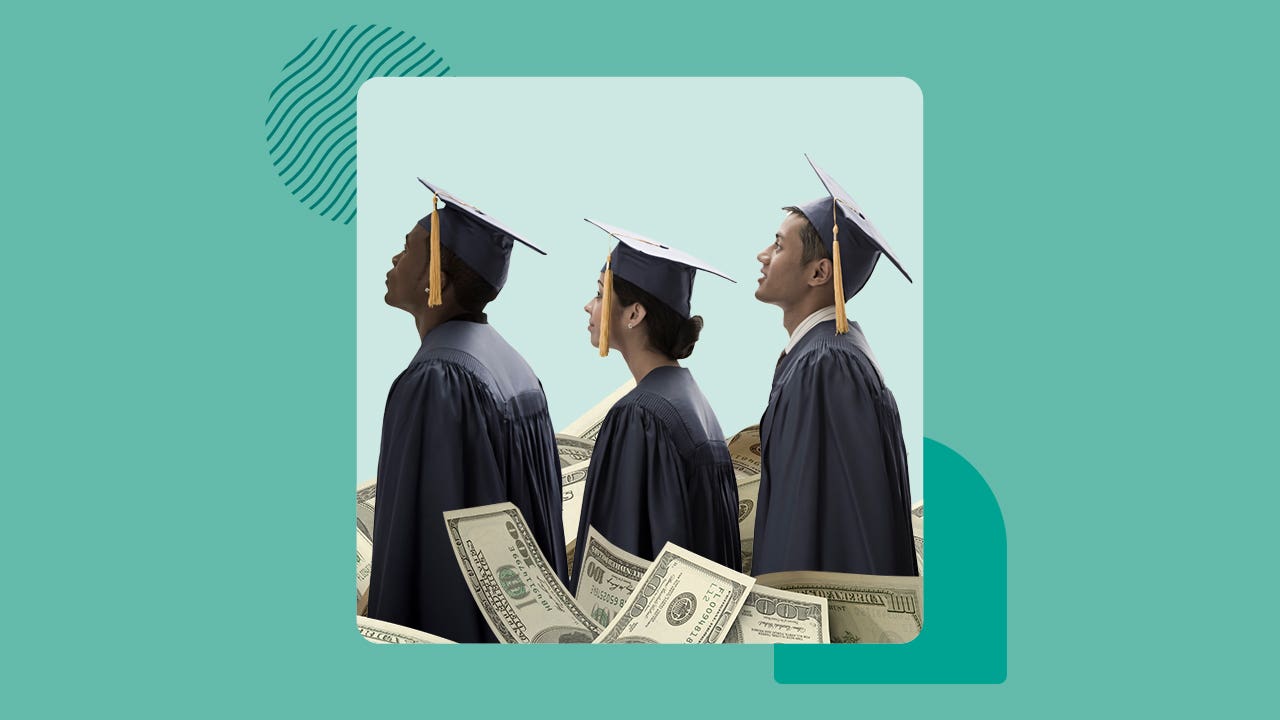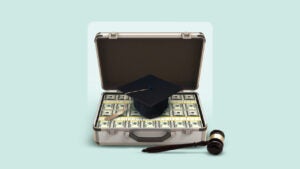Average graduate school debt in 2025

Key takeaways
- Many graduate students take out loans starting at around $45,000 to cover their education costs.
- The cost of graduate school has risen exponentially since 2000, and the majority of students borrow loans to pay for the expense.
- The amount of debt varies greatly by program, with fields in allied health and law having particularly high debt-to-income ratios.
Graduate degrees can elevate your career by helping you better qualify for a job in your field of interest. They can make your resume stand out in a competitive job market, give you the necessary skills to move up the ladder, help you switch industries and boost your salary.
According to Education Data Initiative, students rack up more than $70,000 on average, borrowing the bulk of their loans for graduate programs specifically. The total cost can reach as much as six figures, depending on the school and the program of study you choose. Here are some ways to keep these costs at bay.
Key graduate school student loan debt statistics
- Graduate students in the U.S. leave school with about $46,798 in debt on average, according to Education Data Initiative.
- According to NCES, the average cost of tuition and fees for graduate school at public universities was $12,596 and $28,017 at private schools during the 2021-22 academic year.
- The average annual borrowing amount for graduate school has increased by 233 percent since 2000, according to a report from the Georgetown Center for Education and Workforce (CEW), and some programs have more than tripled in cost.
- According to the Urban Institute, debt-to-earnings ratios tend to be particularly high among allied health graduates, including those in clinical, counseling and applied psychology.
Average student loan debt for a master’s degree
A report updated in 2025 from the Institute for College Access and Success shows debt burdens starting at around $45,000 for many master’s programs, crossing into six-figure territory for professional degrees. These numbers, as with other data, vary widely based on the type of academic institution and the degree program.
Among the 25 programs listed with the average highest student loan debt, many range between $60,000 and $70,000 — three of these programs being in healthcare fields. Others in this list represent a cross-section of master’s programs, including fields like communications and real estate.
The Education Data Initiative reflects similar data, noting that the typical cost of a master’s degree in 2024 was roughly between $44,000 and $71,000. While student loans accounted for the debt burden incurred for an education specifically, graduate students also took on debt in other forms, including higher consumer and mortgage debt rates than the national average after graduation.
Average graduate student loan debt by degree
When it comes to federal student loans, graduate students have two options:
- Direct Loans: With a federal Direct Loan, graduate and professional students can borrow up to $138,500 (or up to $224,000 for health professions), with an 8.08 percent fixed interest rate for 2024-2025 and an origination fee of 1.057 percent. Additionally, federal Direct Loans don’t require you to pass a credit check, and almost anyone in good academic standing is eligible to borrow them.
- Grad PLUS loans: With a grad PLUS loan, you can borrow up to the full cost of attendance, as determined by your school. Unlike federal Direct Loans, grad PLUS loans do require students to pass a credit check and currently have a 9.08 percent fixed interest rate for 2024-2025, plus a 4.228 percent origination fee.
| Loan | Borrowing limit | Fixed interest rate (2024-2025) | Origination fee |
|---|---|---|---|
| Direct Loan | $138,500 | 8.08% | 1.057% |
| Grad PLUS loan | Full cost of attendance | 9.08% | 4.228% |
| Source: studentaid.gov |
Because graduate school is so expensive, most students have to bridge the financial gap by taking out private student loans. While the cost of postsecondary education has steadily increased over the years, the College Board’s 2024 Trends in College Pricing and Student Aid report shows a dip in outstanding student loan debt between 2020 and 2024. These downward trends may partly be due to COVID-era payment pauses and student loan forgiveness activity during those years.
Though the average debt burden has dipped in recent years, trends in recent decades still point to an overall sharp uptick in the cost of higher education. For many students, loans are the solution to paying for degree program costs and living expenses while they study.
Private student loans can have higher interest rates than federal student loans and offer fewer protections and repayment options.
Average graduate student loan debt by program
Most graduate students in the U.S. leave school with upward of $70,000 in graduate school debt. The amount students have to borrow fluctuates greatly by degree type and field of study. For instance, students pursuing a law degree tend to graduate with more than double the amount in student loans than those who choose a master’s in education.
| Program | Average student debt in 2019-2020 (undergraduate + graduate debt) |
|---|---|
| Master of Business Administration | $66,740 |
| Master of Arts | $80,540 |
| Master of Education | $57,360 |
| Master of Science | $64,780 |
| Ph.D. | $68,850 |
| Law | $140,870 |
| Medicine | $199,220 |
| Source: National Center for Education Statistics |
Bottom line
Going to grad school is expensive, but in many cases, the expense can be worthwhile. The most important thing is to research your options — both in terms of cost and financial aid — to ensure you’re making the right choice for your wallet and career.
Why we ask for feedback Your feedback helps us improve our content and services. It takes less than a minute to complete.
Your responses are anonymous and will only be used for improving our website.
You may also like

What is the student loan statute of limitations?

How to pay off medical school debt





